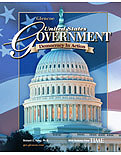U. S. Government: Democracy In ActionChapter 11:
The Federal Court SystemWeb Activity Lesson PlansIntroduction
In this chapter students learned about the federal courts of the United States; how federal judges are selected; and the growth, duties, and jurisdiction of the Supreme Court. In this activity students will visit the Federal Judiciary Web site to take a closer look at the law-interpreting branch of government. Lesson Description
Students will visit the home page of the Federal Judiciary of the United States to learn more about the structure and functions of this branch of government. Students will answer four questions about what they have learned and will then write a "curriculum vitae" for a federal judge. Instructional Objectives - Students will be able to summarize the jurisdiction of federal courts.
- Students will become aware of the importance of public access to court proceedings.
Student Web Activity Answers - By conducting judicial work in view of the public, judges increase the public's confidence in the courts. Allowing public access to proceedings also helps people to learn how the federal court system works.
- The federal courts generally decide cases that involve the U.S. government, the U.S. Constitution or federal laws, and disputes between states or between the United States and foreign governments. Federal courts also handle all bankruptcy matters.
- After a case passes through the District Courts, it would be heard in the U.S. Court of Appeals in its particular region.
- In order to serve as a juror, a person must be a U.S. citizen, must have resided for at least one year in the judicial district, must be proficient in the English language, must be mentally and physically able, and must not have any felony charges pending against him or her.
- Students' advertisements will vary.
 | 




